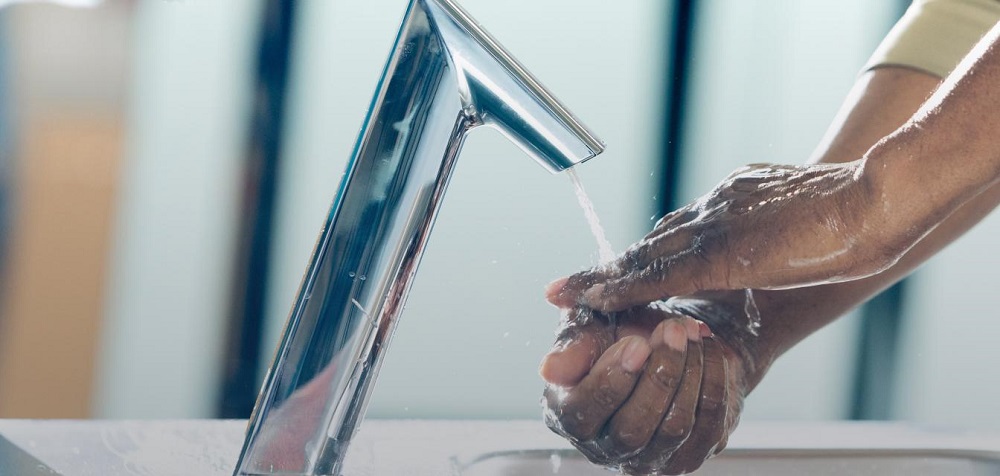Building products carry a greater responsibility than ever before. Gone are the days of where products are just required to operate efficiently. They now also need to make a positive environmental impact as well as the newest trend—making a positive impact on the health of building occupants.
The COVID-19 pandemic has been a catalyst for this increased emphasis on health and wellness in commercial restrooms, but the trend was set in motion long before 2020. That’s why Sloan has worked to become an active member of organizations like the International WELL Building Institute in order to help its products take the next step in this evolution.
Patrick Boyle, Sloan director of corporate sustainability, outlines the company’s wellness goals and the ongoing industry trend.
When did the focus on how buildings impact their occupants’ health begin to gain momentum?
Up until about 2014, the primary focus on sustainable commercial building products was the impact they had on the environment. It was that year that I remember David Gottfried, the co-founder of the U.S. Green Building Council (USGBC), assembled a group of forward-thinking, sustainable companies to form the Regenerative Network.
With Sloan as a part of this group, we met at Greenbuild and they unveiled their plans for the groundbreaking next step in sustainability—the WELL Building Standard, not just how a building impacts the environment, but how to make buildings healthier for the occupants inside. And that movement has been gaining momentum ever since, especially with the COVID-19 pandemic forcing us to look through a different lens of how we make buildings healthier for occupants.
In fact, the number of projects registered to WELL increased over 900% from August 2020 to the end of last month. Sloan is a proud member of the International WELL Building Institute that runs the WELL Building Standard and we’re really excited about the huge focus on healthy buildings.
How was Sloan able to achieve Alliance for Water Stewardship (AWS) certification?
Ever since Sloan was founded in 1906, it’s been a company focused on water efficiency. And as the global standard for water stewardship, it was a logical next step in our evolution. AWS goes beyond water efficiency by showing companies, businesses, schools, and more how to focus on water stewardship. We’re looking beyond just how we’re saving water at our facilities, but to recognize the social, cultural, environmental and economic value of freshwater..
Most companies with AWS certification are large corporations like Pepsi and Nestle with water as the main ingredients in their products, not companies who use water within the manufacturing process, so we’re proud of the distinction.
We’re constantly communicating what it means to be a good water steward and how we can all work together to be water stewards. We engage with our own employees, customers, neighboring businesses, various government entities, environmental groups, and more to help achieve these goals.
How is Sloan and its products helping people live healthier lives?
When you specify Sloan products, you’re able to reduce water consumption by 20 to 50% or even up to 100%, but now, with WELL Building Standards, we’ve been able to move beyond water efficiency and are looking at our products differently. With Sloan products primarily being sensor-based, it helps to cut down on cross-contamination from the “high-touch” restroom surfaces.
From a products perspective, it’s really helped to elevate Sloan to think about the health and well-being of restroom occupants. For example, Sloan hand dryers with HEPA filters are taking the air in the restroom, purifying it, and then blowing it back out for occupants to dry their hands, thus helping to keep the restroom environment healthier and safer.
Aside from products, what resources does Sloan offer to enhance health and wellness?
I think there’s a big appetite out there right now to learn more about WELL and how to make a building healthier, and Sloan is working to provide education on these topics. Digital resources like Sloan’s WELL Building Standard Calculator are helping architects, designers, engineers, and building owners alike understand exactly what they can do to make their building healthier for occupants. The tool also helps them see exactly what WELL-eligible Sloan products to specify to meet the various WELL Building Standard criteria.
The discussion around wellness has come a long way in the last decade. Where do you think this trend goes from here?
I think the ongoing theme will continue to be how we continue to improve health and hygiene outside the restroom. We’re already seeing this with products like Sloan’s Mobile Handwashing Stations that promote hand hygiene in high-traffic areas as we take the attributes of a healthy restroom environment and then apply it elsewhere. This is giving people the chance to wash their hands and stay healthy without even having to go to the restroom.
This is the 29th edition in a series of Q&A segments with Sloan subject matter experts for their take on where the commercial restroom has been, where it’s evolved to now, and where it’s headed. A previous edition on promoting hand hygiene in commercial buildings can be found here.
Stay Up to Date
Sign up for the Sloan blog to receive information on the latest trends in commercial building, technology advancements and product updates. It's the leading source of industry news for architects, designers, engineers and contractors.
